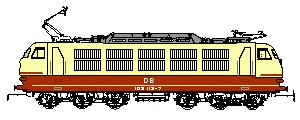
SECOND SET OF PICTURES OF MÄRKLIN LOKS ON MY LAYOUT

SECOND SET OF PICTURES OF MÄRKLIN LOKS ON MY LAYOUT
Click on any small picture to see large pictures of the engine. Click on any large picture to return to this screen.
P
ictures of the DB 610 diesel Red Pendolino, a tilting railcar. The idea, which originated at the end of the 1960's has been thoroughly tested in Italy, a country whose mountainous geography means roads and railway tracks often have to follow rather tortuous routes. The first prototype of the train, the Y0160 built in 1967, quickly earned the nickname 'Pendolino' which has stuck ever since. The Italian State Railways started running the ETR 450 version of the tilting train in 1988 and soon had 15 in service. Now Swiss, Finnish, Spanish, Portuguese and Czech passengers can enjoy the smooth, fast ride on trains whose maximum angle of lean is just 8 degrees, but which can achieve speeds 30 - 35% higher than conventional rolling stock. The German rail company Deutsche Bundesbahn bought 20 VT610 tilting diesel trains some years ago and has recently ordered 83 trains in a new electric version, known as the ICT.P
ictures of the Märklin Class 110 (E10) Express Lok, Märklin 3039. This lok and the Class 140 or E40 look the same except for color. The E 10 is blue and the E 40 is green. They are very different inside. The E 10 was put into service in 1956 as a passenger express lok with a top speed of 90 mph while the E 40 was put into service as a freight lok with a top speed of 60 mph. Both had a tractive force of 5,000 horsepower but had different transmissions. In case you are wondering this engine was advertised in the 1970 Märklin catalog for $26.95.P
ictures of the Märklin Goliath Crane. The largest German railroad crane is called "Goliath" and was built in 1977 by Krupp. It has been stationed in Dortmund, Hannover and Würzburg, constructing bridges, rerailing locomotives and cars, and handling heavy loads. It can lift 150 metric tons within a working radius of up to 8 meters (approx. 26 feet) and can lift 32 metric tons with a radius of 18.5 meters (approx. 61 feet).
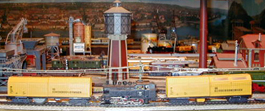
P
ictures of the LUX 9020 "rail grinding wagon", the Schienenschleifwagen, rail cleaner and the LUX 8820 vacuum cleaner, Gleisstaubsauger. These are pushed and pulled by a BR 81, (Märklin 3031). Both the cleaning car and the vacuum car are digitalized with a 6080 decoder. Actually there is no need to digitalize either unit but it is convenient if you use a computer program (i.e., TPL) as I do to control the cleaning of the tracks. The digital function allows me to turn the cars on and off at various points on its route. The Cleaning Car is turned on and off using the function control as you would turn head lamps on and off. The Vacuum Car is control by the speed setting.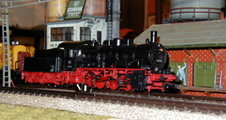
P
ictures of the Märklin (37550) BR 55 (Prussian G8.1) freight "dampflokomotiven". This is a unique coreless-motor engine. As such it is virtually maintenance free. It has great pulling power and runs smoothly. It is seen hauling a consist of ten Shell tank cars. Scenes of the refinery and other sections of the layout can be seen in these photos.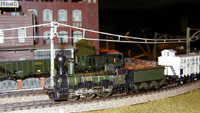
P
ictures of the Märklin (37971) Bavarian Royal State Railways (Königlich Bayerische Staatsbahn, K.Bay.Sts.B.) B VI lok and Märklin (43982) passenger car set. The B VI loks were first manufactured in 1863 and were so successful that 107 engines with variations were built until 1871. These trains ran from Munich to Rosenheim, Simbach, Weilheim, Murnau, Tölz and Schliersee. This engine bears the name Tölz. This train includes a perishable goods car, three passenger coaches and a trailing baggage car. The restroom was located in the baggage car. The B VI was a peat burning engine; note the brown peat in the tender. Peat-fired loks were used in Southern Bavaria while coal was used in the North. These loks had characteristic pear-shaped or ballon-shaped smoke stacks. Note the difference in this engine compared to the B VI lok used with the Peat Transport Train in the link to the group of pictures of the "Peat Train" below.
P
ictures of the Märklin (3797) Bavarian Royal State Railways (Königlich Bayerische Staatsbahn, K.Bay.Sts.B.) B VI lok pulling the Märklin (4897) "Peat Train". This lok was part of the group of B VI's build between 1863 and 1871. They were used for passenger and freight service. One of these engines, with variation, was used for the King Ludwig train. Note the characteristic pear-shaped smoke stack. The detail on this engine is excellent. It is named Murnau for one of the villages serviced by this train. Note the closed tender. These loks were peat-fired. The efficiency of peat as a fuel was affected by moisture so this lok has a closed tender with hoods that can be seen open in the pictures. Also note the peat filled car has a cover. The crane was used for loading the peat. Peat was available in Southern Bavaria while coal was available in the North. A very nice lok and consist.P
ictures of the Märklin (37060) Bavarian Royal State Railways (Königlich Bayerische Staatsbahn, K.Bay.Sts.B.) EP 3/6. Four of these loks were purchased by the K.Bay.Sts.B. as passenger loks. I have assembled a consist of passenger coaches two CCü 3rd Class coaches (Märklin 41351), one ABCCü 1st-2nd-3rd Classes coach (Märklin 41361) and one PPü baggage car Märklin 41371). The EP 3/6 was an AC powered lok but it had a steam boiler to provide heat for the passenger coaches hence the stack in the front and the two pantographs in the rear. The DRG designated these four loks as E 36 - three driving axles with six total axles.P
ictures of the Märklin (37090)P
ictures of the Märklin (49960) Meßwagen. This measurement car is digitally controlled and allows prototypical measurement of speeds, lapsed times and running times. It is seen here being pushed by a DB Class 212 diesel but it is used with all engines to determine there prototypical speeds.P
ictures of the Märklin BR 52 engine. This engine is a powerful engine used to haul freight consists. It is pictured here crossing the trestle bridge with a full head of steam. It is on its way to pick up a consist of lumber cars. This engine came with the snowblower but I switched the condenser engine to pull the snowblower and use this for freight consists.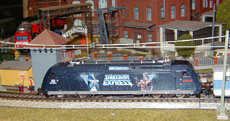
P
ictures of the Starlight Express, Class 101 engine, pulling a Talgo Company InterCity Night train. What better engine than the Starlight Express to pull an overnight train. There are several scenes of the engine on the layout. As the train passes it, look for the lumber yard section of the layout.
P
ictures of the Insider Pneumatic Diesel engine (Märklin 3720). There are two V32's seen in these pictures. The engines were pneumatic engines that used heated air. These engines, first used in 1929, were in use around Stuttgart for several years. The cost effectiveness of these engines was no better than steam loks and their use was discontinued.